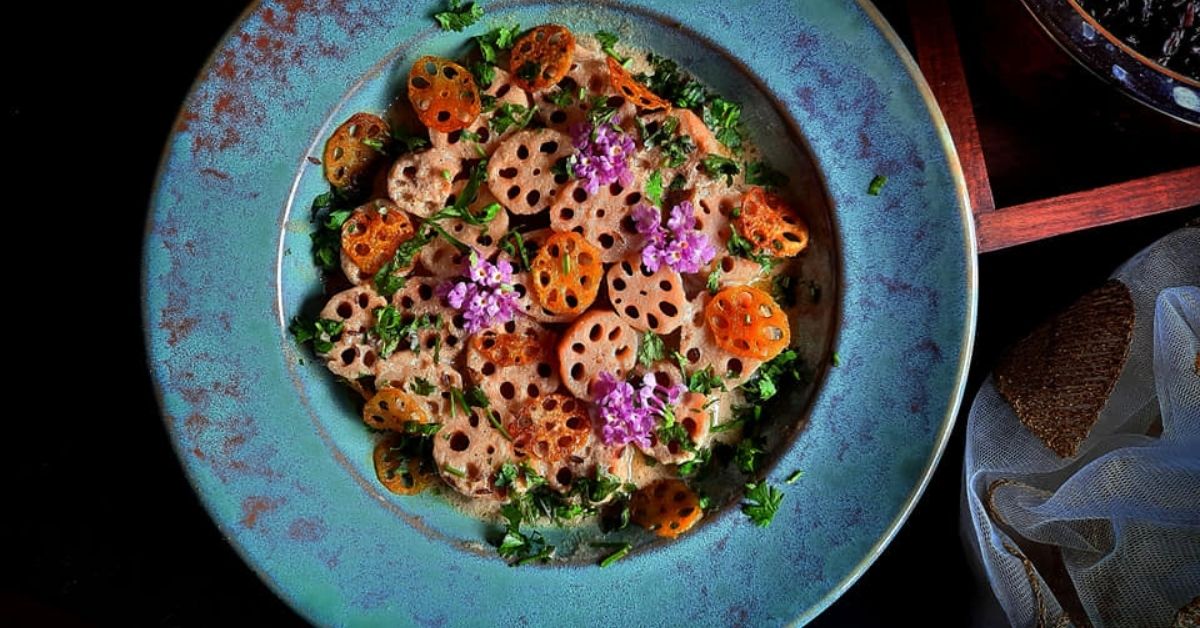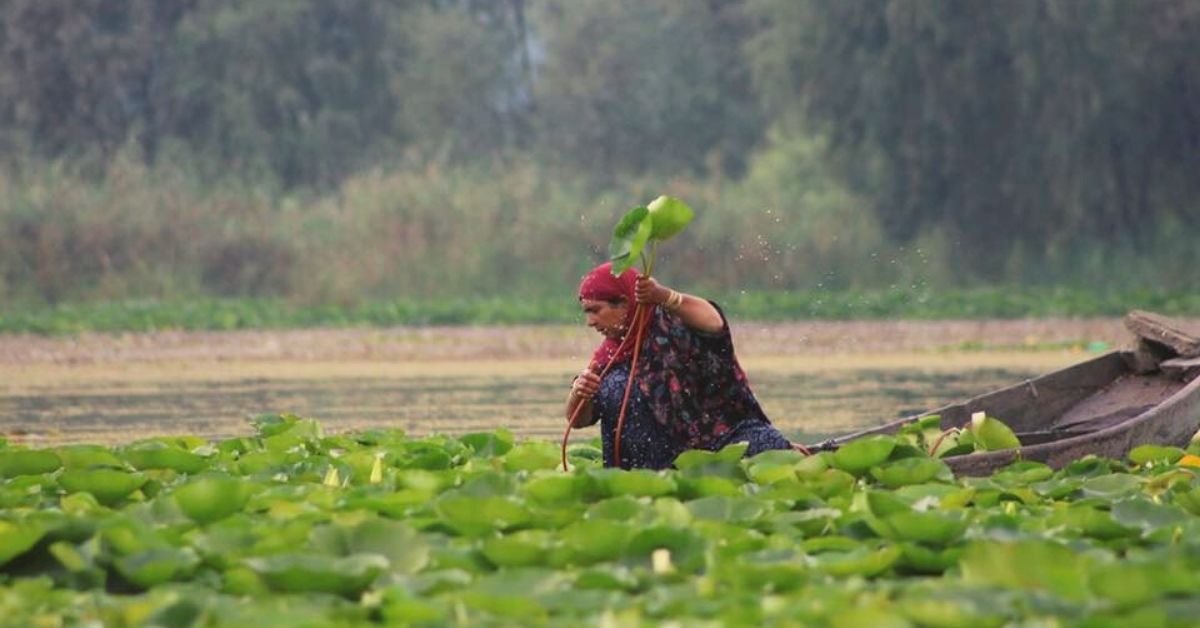A Vegetable Better Than Meat? Kashmiri Delicacy Nadru Has Several Health Benefits
An icon of Kashmiri cuisine, the wonders of nadru or lotus stem go beyond its taste and versatility, owing to its numerous health benefits.

Tucked away in the northernmost region of India, the towering mountains of Kashmir have enveloped centuries-old rich heritage, one that expresses itself through intricate art, architecture and poetry. But in this land of artists, dreamers, emperors and poets, there is a lot more to explore and that journey often starts with a fragrant cup of Kahwah (Kashmiri green tea) and a table full of royal Wazwan (a multicourse Kashmiri meal that consists of meat, rice and vegetables).
Kashmiri cuisine continues to be a highly under-explored culinary reserve and is generally known for its abundance of meat-based dishes. But not many outside the region know that the priceless gem of Kashmiri cuisine is not another protein-based rich and complex preparation, but the humble Nadru, or lotus stem—also known as lotus root—indigenously grown across its picturesque lakes.
A porous and fibrous lake vegetable that was once commonly available, Nadru grew to become an irreplaceable ingredient in a traditional Kashmiri kitchen. From regular consumption to festivals, Nadru earthy and fibrous texture allowed it to be very versatile. From being cooked with green beans in dal, or fried into light and crispy street food called nadir monje, Kashmir’s lotus stem, over decades has grown to become representative of the region, so much so that it has the power to replace the usually superior lamb in traditional yoghurt and a cumin-based dish called yakhni. Known as nadru yakhni, this dish is specially cooked during Nowruz, the Iranian New Year which is popularly celebrated across the Kashmir valley.
A vegetable as good as meat

Nadru’s discovery as a culinary gem dates back to the 15th century during the reign of the eighth sultan of Kashmir, Ghiyas-ud-Din Zain-ul-Abidin. According to local accounts, while on a shikara ride on the Gil Sar lake located in the exteriors of Srinagar, the emperor was first introduced to the brilliance of a lotus plant. Locally harvested by his boatmen, the emperor was served a special evening meal with lotus stems or nadru.
Already captivated by the beauty of lotus flowers, Zain-ul-Abidin was shocked to know that the chewy flavourful dish was made out of lotus stem. Captivated by the striking beauty of the plant’s flower and the subtle and sophisticated taste of its stem, he decided to introduce lotus in all the lakes of Kashmir, thus making it a mainstream delicacy available for everybody.
Moreover, the chefs who migrated from Samarkand city of Uzbekistan to the valley during the 15th-century invasion by Timur, a Turco-Mongol conqueror, used their spices and skills to elevate the ingredient’s brilliance like no other. Soon, from royal kitchens to common households, Nadru began to dominate Kashmiri kitchens with its steamed, boiled, fried and spiced dishes.
Owing to its versatility, this food has become a symbol of Kashmir. It is said to be consumed by both Muslims and Pandits, especially during fasts. Its porous texture allows for it to thoroughly absorb all the rich spices and makes for an impressive alternative to mutton or beef while making kebabs, curries and yakhni. According to many from the region, it is a vegetable as good as meat!
A medicinal bounty

Beyond being a culinary gem, lotus stem or Nadru has several medicinal properties that elevate its gastronomic importance significantly.
Low in saturated fat and cholesterol, it is also a rich source of dietary fibre, nutrients and minerals like vitamin C, vitamin B, vitamin E, potassium, thiamin, phosphorus, iron, copper, manganese and pantothenic acid. Known to be a fat-free vegetable, it is packed with phytonutrients that help in building up a robust immune system and reduce the risk of heart diseases and strokes. With good vasodilator properties, Nadru is also said to improve blood circulation and help manage blood pressure. And with vitamin B complex and pyridoxine in it, Nadru is known to aid in reducing stress considerably. Pyridoxine found in the lotus stem also contributes to improving heart health in general.
Also, the abundance of fibre content helps prevent constipation and aids in the digestion process. Eating it once or twice a week, for people suffering from gut-related problems, is often said to be beneficial.
A seemingly simple vegetable indigenously grown in not just Jammu & Kashmir but several parts of India and beyond, lotus stem has proven itself to be a marvel both in terms of taste and health. But in this region that has survived through several natural and man-made hardships, Nadru continues to be relished as a bite of love and comfort.
Recipe: Nadru Yakhni

Ingredients
Lotus stem- 1 cup
Curd- 2 cups
Dry ginger powder- 1 teaspoon
Carom seeds (Ajwain)- 2 teaspoons
Fennel seeds (Saunf), powdered- 1 teaspoon
Garam masala powder- 1 teaspoon
Black cardamom (Badi Elaichi)- 2
Cardamom (Elaichi)- 2
Cloves (Laung)- 2
Cinnamon Stick (Dalchini)- 1 inch
Bay leaf (Tej Patta)- 1
Gram flour (Besan)- 1 tablespoon
Asafoetida (Hing)- 1/4 teaspoon
Ghee- 3 to 4 tablespoons
Salt, to taste
Method
Peel the skin of the lotus stem and slice them into thin pieces. Rinse well in water and cook in a pan until tender. Be careful not to overcook them or mash them. It should be cooked enough to hold its form.
Whisk curd, water and besan into a thick batter.
Heat 3 tablespoons of ghee in the pan and add cumin seeds to splatter.
Pour the curd and besan batter and bring it to a boil on simmer for around 10 minutes.
Add the cooked lotus stem and the powdered masalas. Continue to cook on low flame for 5 minutes.
Take another pan and melt the ghee. Add cumin seeds and let them splatter for a few seconds before adding cinnamon, cloves, bay leaf and cardamom. Fry until the aroma is emitted and sprinkle asafoetida. Turn the flame off.
Pour this tadka into the curd-besan gravy and mix well. Turn the flame off immediately.
Nadru yakhni is ready and can be garnished with a sprinkle of dried mint before serving with naan.
(Edited by Yoshita Rao)
This story made me
- 97
- 121
- 89
- 167
Tell Us More
We bring stories straight from the heart of India, to inspire millions and create a wave of impact. Our positive movement is growing bigger everyday, and we would love for you to join it.
Please contribute whatever you can, every little penny helps our team in bringing you more stories that support dreams and spread hope.



















